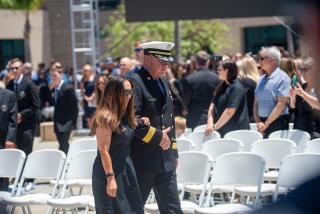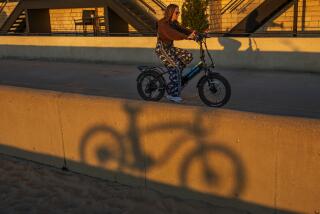RECREATION : A Tragic Lesson About Helmets : One Death That Might Have Been Avoided
- Share via
The picture is moving in its simplicity: a snapshot of a father and son that in another time, in happier circumstances, might have been lost in the stacks of photos that chronicle one family’s life.
But to Hugh Cherry, it is a cherished reminder of the past, and of a son who laughed and cried and left an indelible mark of happiness and hope on all who knew him.
Timothy Robert Cherry, standing on the beach with his father, a broad smile crossing his tanned face, is dead--and Hugh Cherry doesn’t want to forget.
Timothy Cherry was 27 when he died on a flat stretch of state highway north of Mesa, Ariz., in July, 1989. It was 6:30 in the morning, the skies were clear, and he was doing what he loved--riding his beloved Cannondale 12-speed bicycle.
He seemed to be doing everything right: riding with the flow of traffic, far to the right side of the road. But the driver of the Tioga motor home apparently didn’t see him in time, and when the right-front fender clipped the Cannondale, Timothy Cherry was thrown violently forward.
In the flat, emotionless language of the police report, to be precise, Timothy Cherry was “thrown approximately 106.2 feet to the right at a slight angle, and came to rest 20.4 feet from the east edge of the northbound lane.”
Cherry, a Huntington Beach native and accomplished triathlete, died of massive head injuries.
He was not wearing a helmet.
And now Hugh Cherry, in remembering his son, is determined that everyone know that his son might be alive today if he had.
“Tim didn’t have a helmet on when he died, and if he had he may have been left a vegetable--we just don’t know,” said Cherry, a retired broadcaster who lives in Seal Beach. “What I do know is that wearing a helmet improves your chances.
“I think he was anticipating there not being much traffic that early in the morning. He exercised the same kind of carelessness that we all exercise on occasion. I would be the last one to blame Timothy for that accident. But I think if he hadn’t been out on the road, it wouldn’t have happened. And he should have been wearing a helmet.”
Hugh Cherry remembers his son as a classic triathlete, lean and “all sinew and bone.” He grew up in Huntington Beach, attended Arizona State University and settled in Fountain Hills, Ariz., working in landscaping.
It was four years ago that Timothy, worried about his father’s health, persuaded him to take up bicycling.
“I had smoked for 46 years,” Hugh Cherry said. “I’m incapacitated with emphysema, and my bicycle is recommended for my health. My son said, ‘You don’t need to run, ride a bicycle.’ I did it and took to it immediately. Here I am, partially incapacitated riding a bike.”
Cherry now rides his Univega mountain bike almost every day, from Bolsa Chica to the Santa Ana River, along the beach in Huntington Beach and back. The week of Oct. 7, when he turned 68, Cherry put in 260 miles. He is concerned, he said, by what he sees as careless riders--those who ride too fast and those who ignore the basic rules of bicycle safety.
“The bike paths have become increasingly dangerous because of the hotdogs,” Cherry said. “The hotdogs sail through there at 18 miles an hour in a 10-mile-per-hour speed limit. They whip through pedestrians, people walking dogs. There are places along the beach where I would rather get on PCH than the bike path because it is so dangerous.”
“Another thing that bothers me,” he added, are people who ride without helmets.
“I am tempted to take off my own helmet, but I have to say to myself, ‘Hey man, remember Tim.’ The thing that really bothers me is seeing someone with a baby seat on the back of a bike and the kid with no helmet. I once saw an adult who had a helmet on, but the child didn’t. My heart just broke for that child.
“People don’t realize how fast accidents can happen--in a flash of an eye. If that kid goes down, he is going to be damaged. The speed he gains from falling that three feet is enough to kill him. I was in a hospital recently, and the halls were full of motorcycle and bicycle accident victims . . . . They were all vegetables.”
Hugh Cherry has continued riding. He holds closely two reminders of his son’s life.
“(Timothy) gave me my (bicycle) odometer for Father’s Day last year. He was killed July 19th. That was the last gift he gave me. My daughter gave me one of my son’s helmets, and I treasure it. Tim gave me a lot of joy, but riding a bicycle is the greatest thing he ever gave me.”
Experts say that the deaths of people like Timothy Cherry can often be avoided if only cyclists would invest $40 in a helmet. One place where the message is being spread effectively is in Irvine, where the Irvine Bicycle Club has made helmet safety one of its pet projects.
Armed with statistics showing an alarming number of children injured in bicycle-related accidents, the club has embarked on a program to get children wearing helmets early, and often.
“We felt, more than just as a bicycling-riding recreational club, that we should get involved in helmet awareness,” said Richard Martin, 51, president of the Irvine Bicycle Club, which boasts more than 800 members. “We have held a bicycle rodeo and gotten helmets to sell or give away at cost. We’re looking for more ways to get helmets to kids and their parents.”
Martin, a resident of Fountain Valley, said the club’s efforts are aimed at both the children and their parents.
“The resistance you get is not from 5- to 9-year-olds but from the 12- to 18-year-olds. It’s just that peer pressure . . . the kids who don’t want to mess up their hair or look nerdy or whatever. A lot of progressive communities feel that if you can get to the kids young enough, they will start wearing them.”
For parents, Martin said, “it’s like wearing a seat belt. All the parents we’ve ever talked to say they would love for their kids to wear helmets. But I’m not sure how many of them really stop to think about it. It’s just a matter of getting to them. I’m not sure they realize how important this is.”
Consider, Martin said, some of the statistics, compiled from various consumer agencies:
Nearly 400,000 children under the age of 14 are treated across the nation each year for bicycle-related injuries in hospital emergency rooms. There are half a million more bicycle-related injuries that are medically attended to in other than emergency-room settings.
A third of all child bicyclists treated in hospital emergency rooms suffer head injuries.
About 600 bicyclists under age 14 die each year. About 80% of them suffer head trauma. This number, Martin notes, exceeds the combined death ate from accidental poisonings, falls and firearm injuries to children.
Over 50% of all fatal injuries occur when a child rides out into the street from a sidewalk or driveway and collides with a motor vehicle.
Martin cited estimates from consumer groups predicting that bicycle helmets could reduce the risk of serious head injury by 85%, yet less than 2% of the children who ride bicycles wear helmets.
One of the great myths, Martin said, is the idea among cyclists that as long as they don’t ride fast they don’t need a helmet.
“They think they won’t hit the pavement hard, but anyone who rides a bike can tell you that isn’t true,” he said. “There really is no excuse for not wearing a helmet. We can save lives with just a little investment. If what our club is doing helps, even a little bit, then we’ve done some good.”
More to Read
Go beyond the scoreboard
Get the latest on L.A.'s teams in the daily Sports Report newsletter.
You may occasionally receive promotional content from the Los Angeles Times.










